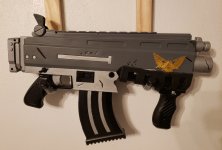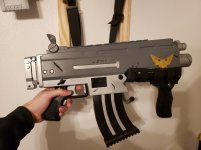40k is a common topic of discussion in what ifs and vs. A lot of arguments however come down to questions of what equipment can actually do.
Thus, this thread, with a goal of discussing "reasonable" stats for 40K equipment, to hopefully in the end act as forum headcannon for future discussion, if this is at all successful. Otherwise, hopefully it will at least be interesting as a topic of discussion.
To begin with, the "Imperial" Bolter, as in the Bolter used by normal humans.
I was initially thinking of shrinking it down to 50 cal, to allow more rounds, and to be more directly comparable to the .50 action express, the Desert Eagle caliber, as well as the 50 cal round. And, in a comfortable 6 inch long magazine, .5 caliber allows 10 rounds reasonably comfortably in a single stack, 18 or so in a double stack magazine.
However, taking the design seriously as a rocket propelled round, going up to the canonical 0.75 caliber round made sense, for one primary reason: explosive filler: 0.5 caliber, or 12.7 mm, with a short bluntish shape has maybe 4 cm^3 of volume. A solid steel bullet at 8 g/cm^3 would weigh 32 grams, in line with high end desert eagle rounds.
However, a proper Bolter round has high volume of explosive filler, something the rocket propelled nature makes more viable (not requiring as thick walls). 1 cm^3 steel, 2 cm^3 explosives (1.7 g/cm^3), and 1 cm for detonator mechanism, say 2 grams. This would only be a 13.4 gram projectile, only a little heavier than a 7.62 round. A larger diameter penetration would likely be lower. This does not fit what a bolter should be.
0.75 inch/20 mm round however in a 40 mm long projectile gives a volume of roughly 12 cm^3, maybe round down to 10 cm^3 for aerodynamics. This round if you give 3 cm^3 to trigger mechanism, putting less miniaturization pressure, 3 cm^3 to steel, and 4 cm^3 to explosives, you have a roughly 30 gram projectile with 6 grams of explosive filler. This seems much more in line with what a bolter should be.
Solid rocket fuel has an exhaust velocity of roughly 2,500 m/s, with roughly equal density to high explosives. 20 mm of rocket behind the 0.75 cal round could hold roughly 10 grams of fuel. Basic rocket equation this is a muzzle velocity of 719 m/s. Realistically, a rocket round needs a casing, so it might be 10 extra grams of casing brings total mass up to 50 grams and muzzle velocity down to 557 m/s, practical maybe 450 m/s post air resistance.
Thus, your bolt pistol round is 0.75 inch wide and 3 inch long, with 30 grams of steel shell, 6 grams of explosives, 10 grams of fuel, and 4 grams for the trigger or other mechanisms, for 50 grams total. 450 m/s muzzle velocity is 4 KJ, and explosive power roughly 20-30 KJ of explosive power. This theoretically gives it roughly 8 mm of armor penetration. This design is much more an explosive weapon than a kinetic weapon though.
This gives a round in a manageable length for human handling, and in a 6 inch magazine, you can still fit roughly 6, leaving space for a conventional spring system, containing only about 300 grams of ammo, or half a pound. Double stacked magazine you can get to roughly 10-11 rounds, with roughly 500 grams/1lb of ammo. For a true brick of a 4 stack, 20-24 rounds, though your dealing with a full kilo of ammo per magazine.
This gives a pistol with reasonable ammo, pistol acceptable muzzle velocities, and significant firepower in still man handleable loads.
A rifle Bolter round may add roughly 2 inch to overall length to add roughly 20 more grams of rocket fuel. 50 gram of projectile, 30 grams of fuel boosts velocity to 1,175 m/s, maybe 940 m/s effective. Kinetic energy 22 KJ, same explosive power of 20-30KJ. Theoretical armor penetration is 20 mm. Overall length 5 inches, 80 gram round. A larger 10 inch magazine might allow for 10 rounds single, to 40 round quadruple, at ammo weights of 800 grams - 3.2 kg (1.75 lb-7 lbs). This is a very big magazine, and you can't really go prone with it.
So, what do people think?
Thus, this thread, with a goal of discussing "reasonable" stats for 40K equipment, to hopefully in the end act as forum headcannon for future discussion, if this is at all successful. Otherwise, hopefully it will at least be interesting as a topic of discussion.
To begin with, the "Imperial" Bolter, as in the Bolter used by normal humans.
I was initially thinking of shrinking it down to 50 cal, to allow more rounds, and to be more directly comparable to the .50 action express, the Desert Eagle caliber, as well as the 50 cal round. And, in a comfortable 6 inch long magazine, .5 caliber allows 10 rounds reasonably comfortably in a single stack, 18 or so in a double stack magazine.
However, taking the design seriously as a rocket propelled round, going up to the canonical 0.75 caliber round made sense, for one primary reason: explosive filler: 0.5 caliber, or 12.7 mm, with a short bluntish shape has maybe 4 cm^3 of volume. A solid steel bullet at 8 g/cm^3 would weigh 32 grams, in line with high end desert eagle rounds.
However, a proper Bolter round has high volume of explosive filler, something the rocket propelled nature makes more viable (not requiring as thick walls). 1 cm^3 steel, 2 cm^3 explosives (1.7 g/cm^3), and 1 cm for detonator mechanism, say 2 grams. This would only be a 13.4 gram projectile, only a little heavier than a 7.62 round. A larger diameter penetration would likely be lower. This does not fit what a bolter should be.
0.75 inch/20 mm round however in a 40 mm long projectile gives a volume of roughly 12 cm^3, maybe round down to 10 cm^3 for aerodynamics. This round if you give 3 cm^3 to trigger mechanism, putting less miniaturization pressure, 3 cm^3 to steel, and 4 cm^3 to explosives, you have a roughly 30 gram projectile with 6 grams of explosive filler. This seems much more in line with what a bolter should be.
Solid rocket fuel has an exhaust velocity of roughly 2,500 m/s, with roughly equal density to high explosives. 20 mm of rocket behind the 0.75 cal round could hold roughly 10 grams of fuel. Basic rocket equation this is a muzzle velocity of 719 m/s. Realistically, a rocket round needs a casing, so it might be 10 extra grams of casing brings total mass up to 50 grams and muzzle velocity down to 557 m/s, practical maybe 450 m/s post air resistance.
Thus, your bolt pistol round is 0.75 inch wide and 3 inch long, with 30 grams of steel shell, 6 grams of explosives, 10 grams of fuel, and 4 grams for the trigger or other mechanisms, for 50 grams total. 450 m/s muzzle velocity is 4 KJ, and explosive power roughly 20-30 KJ of explosive power. This theoretically gives it roughly 8 mm of armor penetration. This design is much more an explosive weapon than a kinetic weapon though.
This gives a round in a manageable length for human handling, and in a 6 inch magazine, you can still fit roughly 6, leaving space for a conventional spring system, containing only about 300 grams of ammo, or half a pound. Double stacked magazine you can get to roughly 10-11 rounds, with roughly 500 grams/1lb of ammo. For a true brick of a 4 stack, 20-24 rounds, though your dealing with a full kilo of ammo per magazine.
This gives a pistol with reasonable ammo, pistol acceptable muzzle velocities, and significant firepower in still man handleable loads.
A rifle Bolter round may add roughly 2 inch to overall length to add roughly 20 more grams of rocket fuel. 50 gram of projectile, 30 grams of fuel boosts velocity to 1,175 m/s, maybe 940 m/s effective. Kinetic energy 22 KJ, same explosive power of 20-30KJ. Theoretical armor penetration is 20 mm. Overall length 5 inches, 80 gram round. A larger 10 inch magazine might allow for 10 rounds single, to 40 round quadruple, at ammo weights of 800 grams - 3.2 kg (1.75 lb-7 lbs). This is a very big magazine, and you can't really go prone with it.
So, what do people think?






